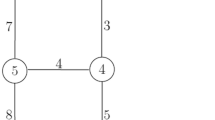Abstract
The design of water distribution networks (WDNs) is an optimization problem with minimization of pipes and their associated installation costs as the objective function. In this problem, securing the allowable minimum pressure or the allowable maximum velocity in the demand pattern is important. A reliable long-term system requires a high reliability when first designed. Thus, assessment of the network condition during the operational period, when it is first designed, can be an effective way to increase the network efficiency. In addition, consideration of uncertainty of network parameters is important. This paper develops a probabilistic model based on the Monte Carlo simulation (MCS) method to assess effects of those uncertainties simultaneously in the long-term performance of the network by considering various scenarios for variations of nodal demands and pipe roughness using different values of the coefficient of variation (CV) as the uncertainty measure. Consumption nodal demands and pipe roughness in a benchmark two-loop network are considered as uncertain variables. Calculation of a deterministic performance (failure) index (I f ) for various generated probabilistic scenarios in the MCS method during a 30-year operational period simulation in this network show that an increase of uncertainty in each variable separately causes a decrease in the deterministically-designed network efficiency. Sensitivity of changing the average value of I f calculations show a nodal demand deficit of 45 % and a nodal pressure deficit of 61 % during the operational period. This condition shows the necessity of considering uncertain changes of variables simultaneously during the operational period in the design of WDNs.











Similar content being viewed by others
References
Alperovits A, Shamir U (1977) Design of optimal water distribution systems. Water Resour Res 13(6):885–900
Babayan A, Kapelan Z, Savic D, Walters G (2005) Least-cost design of water distribution networks under demand uncertainty. Water Resources Planning and Management 131(5):375–382
Beygi S, Bozorg Haddad O, Fallah-Mehdipour E, Mariño MA (2013) Bargaining models for optimal design of water distribution networks. Water Resources Planning and Management. doi:10.1061/(ASCE)WR.1943-5452.0000324
Bhave PR (1981) Node flow analysis of water distribution systems. J Transp Eng 107(4):457–467
Bozorg Haddad O, Adams BJ, Mariño MA (2008) Optimum rehabilitation strategy of water distribution systems using the HBMO algorithm. Water Supply Research and Technology, (AQUA) 57(5):337–350
Eusuff MM, Lansey KE (2003) Optimization of water distribution network design using the shuffled frog leaping algorithm. Water Resources Planning and Management, (ASCE) 129(3):210–225
Fallah-Mehdipour E, Bozorg Haddad O, Beygi S, Mariño MA (2011) Effect of utility function curvature of Young’s bargaining method on the design of WDNs. Water Resources Management 25(9):2197–2218
Ghajarnia N, Bozorg Haddad O, Mariño MA (2011) Performance of a novel hybrid algorithm in the design of water networks. Proceedings of Institution of Civil Engineers Water Management 164(4):173–191
Jung D, Chung G, Kim JH (2010) “Optimal design of water distribution systems considering uncertainties in demands and roughness coefficients.” 12th Annual Conference on Water Distribution Systems Analysis (WDSA), Tucson, Arizona, United States, September 12–15
Kapelan Z, Savic DA, Walters GA (2005) Multiobjective design of water distribution systems under uncertainty. Water Resour Res 41(11):11407–11415
Mays LW (1996) “Review of reliability analysis of water distribution systems.” Stochastic Hydraulic 96, KS Tickle et al (eds), A.A. Balkema, Rotterdam, The Netherlands, 53–62
Morgan DR, Goulter IC (1985) Optimal urban water distribution design. Water Resour Res 21(5):642–652
Rossman LA (2000) “EPANet 2 users manual.” United States Environmental Protection Agency, Cincinnati, Ohio, USA
Rowell WF, Barnes JW (1982) Obtaining the layout of water distribution systems. Hydraulic Division, (ASCE) 108(1):137–148
Sabbaghpour S, Naghashzadehgan M, Javaherdeh K, Bozorg Haddad O (2012) HBMO algorithm for calibrating water distribution network of Langarud city. Water Sci Technol 65(9):1564–1569
Seifollahi-Aghmiuni S, Bozorg Haddad O, Omid MH, Mariño MA (2011) Long-term efficiency of water networks with demand uncertainty. Water Management 164(3):147–159
Seifollahi-Aghmiuni S, Bozorg Haddad O, Omid MH, Mariño MA (2013) Effects of pipe roughness uncertainty on water distribution network performance during its operational period. Water Resources Management. doi:10.1007/s11269-013-0259-6
Sharp WW, Walski TM (1988) Predicting internal roughness in water mains. American Water Works Association 80(11):34–40
Soltanjalili M, Bozorg-Haddad O, Mariño MA (2011) Effect of breakage level one in design of water distribution networks. Water Resources Management 25(1):311–337
Soltanjalili M, Bozorg-Haddad O, Mariño MA (2013a) “Operating water distribution networks during water shortage conditions using hedging and intermittent water supply concepts.” Water Resources Planning and Management, In Press
Soltanjalili M, Bozorg-Haddad O, Seifollahi-Aghmiuni S, Mariño MA (2013b) Water distribution networks simulation by optimization approaches. Water Science and Technology, Water Supply. doi:10.2166/ws.2013.086
Su YL, Mays LW, Duan N, Lansey KE (1987) Reliability based optimization for water distribution system. Hydraulic Engineering, (ASCE) 113(12):589–596
Surendran S, Tanyimboh T, Tabesh M (2005) Peaking demand factor-based reliability analysis of water distribution system. Adv Eng Softw 36(11–12):789–796
Taebi A, Chamani MR (2005) “Urban water distribution networks.” Second edition, publication center of Isfahan Industrial University, Isfahan
Todini E (2000) Looped water distribution networks design using a resilience index based heuristic Approach. Urban Water 2(3):115–122
Tolson BA, Maier HR, Simpson AR, Lence BJ (2004) Genetic algorithm for reliability-based optimization of water distribution systems. Water Resources Planning and Management, (ASCE) 130(1):63–72
Xu C, Goulter IC (1998) Probability model for water distribution reliability. Water Resources Planning and Management, (ASCE) 124(4):218–228
Xu C, Goulter IC (1999) Reliability-based optimal design of water distribution networks. Water Resources Planning and Management, (ASCE) 125(6):352–362
Author information
Authors and Affiliations
Corresponding author
Rights and permissions
About this article
Cite this article
Seifollahi-Aghmiuni, S., Bozorg Haddad, O. & Mariño, M.A. Water Distribution Network Risk Analysis Under Simultaneous Consumption and Roughness Uncertainties. Water Resour Manage 27, 2595–2610 (2013). https://doi.org/10.1007/s11269-013-0305-4
Received:
Accepted:
Published:
Issue Date:
DOI: https://doi.org/10.1007/s11269-013-0305-4




